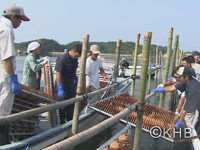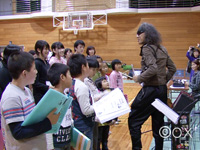Documentary : Disaster , Disaster Management
![]()
Daring Attepmt of Oystermen to Overcome Earthquake Adversity
DC371412![]()
三陸カキ 真の復興に挑む [KHB]
![]()
![]()


|Length : 24min. |Year : 2014 |
The oystermen on the Sanriku Coast of Japan suffered great losses in the tsunami wrought by the 2011 Tohoku Earthquake. A good 90% of the oyster cultivation facilities in Miyagi Prefecture, nearly 12,000 of them, were lost. There are men here who are attempting to bounce back from this adversity through a new venture. They consist of Hiroaki Saito, operator of an online oyster sales company, and 20 oystermen from six coves within the prefecture.
The Sanriku oyster industry has been plagued by problems such as an aging population and a lack of successors. In order to create a life better than that they led before the disaster, they must produce and market greater numbers of oysters in their shell. To that end, they decided to adopt cultivation methods used by oystermen in France, one of the world’s leading oyster producing nations.
This program chronicles the attempts by these oystermen to restore the cultivation of Sanriku oysters.
732 days: The lives of 3 orphans post earthquake
DC371311![]()
3人で生きる 震災孤児 兄弟が歩んだ732日 [KHB]
![]()
![]()


|Length : 24min. |Year : 2013 |
March 11, 2011. The huge tsunami that hit in the Tohoku earthquake swept away the parents of many children, leaving large numbers orphaned. There are more than 241 children in Miyagi, Iwate and Fukushima prefectures whose parents were either killed in the disaster or remain missing. How did these children face the aftermath of the disaster, and move on without their parents?
Shohei Takeyama (19 at the time of the disaster), lives in Ishinomaki City in Miyagi Prefecture, and lost both his parents and grandfather to the tsunami. His younger sister Yuuki is a high school student, while brother Naoki is in junior high school.
"All I want is for us to live a normal life. At the very least, I want to give my brother and sister a normal upbringing. I feel it is what I should do for my parents."
Shohei decides to become his siblings' legal guardian. Initially, Naoki and Yuuki were taken to live at an aunt's home in Ishinomaki, but once Shohei turns 20, he becomes their guardian by law (as they are both still minors), in place of their parents.
A year after the disaster, they leave their home in Ishinomaki and move into an apartment together in Iwate Prefecture's Sendai City.
Yuuki enters the same university as Shohei, and is busy with study as well as part time work. Naoki has changed schools, and is taking the first steps toward high school entrance exams, while Shohei is in the middle of intense job hunting. He hopes to find work at a company with no risk of being transferred outside Iwate Prefecture, so they can continue living together.
The three siblings suddenly had their family torn apart forever on that fateful day. This is a document of the reality they face living without their parents over the two years following the disaster: holding the memories of their parents in their hearts, while supporting each other as a family.
Kirari Fukushima – Back on Track! Bringing Spirit to Fukushima Disaster Victims on a Steam Train
DC371210![]()
ふくしまの大地に響け!SL福島復興号 [TUF]
![]()
![]()


|Length : 47min. |Year : 2012 |
In July 2012, a steam locomotive returned to the Tohoku Line in Fukushima Prefecture for the first time in 45 years. Billowing black smoke as it powered through the Fukushima countryside, the majestic train swept away memories of the Great East Japan Earthquake, a disaster which drastically changed the idyllic lives of the people of Fukushima.
The project, christened the Fukushima Smile Project, was put into motion by staff at East Japan Railway to give hope and strength to the disaster-stricken prefecture.
A C61 type steam locomotive that had formerly worked the Tohoku Line was revived for the project. Named the Fukushima Revival Express, the train was operated by local drivers from Aizu Wakamatsu. The documentary follows the drivers as they work on the project, showing their thoughts and feelings as they drive the steam train through their home prefecture.
Steam locomotives inspire awe in children and bring back memories for baby-boomers. Operating between Koriyama and Fukushima Stations, the Fukushima Revival Express carried the hopes of many and gave strength to the people of Fukushima as they grappled with the effects of the Great East Japan Earthquake. More than 30,000 people praying for Fukushima's recovery gathered along the tracks to wave as the train went by.
This program documents people's emotions as the steam locomotive is resurrected and follows the train as it makes its journey through the prefecture on a day which brings courage and emotion to disaster-stricken Fukushima.
Bouncing Back with Family Ties
DC371209![]()
イチゴがつなぐ家族の絆 [OX]
![]()
![]()


|Length : 24min. |Year : 2012 |
Yamamoto in Miyagi Prefecture was Tohoku's biggest strawberry-growing region. Nearly all of the 130 strawberry farmers' holdings were destroyed in the Great East Japan earthquake and tsunami. Takao Kanno has spent over 40 years growing strawberries. He lost both his home and greenhouses.
The four generations and eight members of the Kanno family all survived. But no big family can survive without an income. Takao quickly rented land from friends to begin growing strawberries again. Nine months after the disaster he reaps a harvest. Yet he cannot rely on borrowed land for future seasons. He hopes to rebuild a big greenhouse on the same spot as the old one and set up a strawberry farm for visitors. It will cost about 20 million yen. When added to the cost of rebuilding the family home the Kannos are looking at enormous debts.
Takao's son, Takaaki is focusing on construction work to earn money for the family. But a delay in rebuilding the greenhouse threatens next year's harvest. Takao insists that rebuilding is more important in the long term than earning money now. The two men also argue over the site of the new home. It isn't easy for the two to reach mutual agreement.
Meanwhile strawberry farmer Hiroyuki Suzuki is from the nearby town of Watari. He and his family have moved to Hokkaido to begin growing strawberries there. They chose the security of a daily wage and housing aid to help raise their two young children.
The second spring since the disaster dawns.
Takaaki's oldest son Shohei has Down syndrome. His dislike of strawberries meant he couldn't even tolerate their smell. Yet he starts to lend a hand in the greenhouse in order to help his family. Takaaki takes time off work to focus on rebuilding the greenhouses. Shohei's two little sisters have also begun to help out where they can. The Kanno family come together to rebuild greenhouses on the site of their old farm. Having weathered disaster, their family bond has grown even tighter.
Pass Down The Great Earthquake Experience
DC371208![]()
ともにエピソード それぞれのありがとう [OX]
![]()
![]()


|Length : 33min. |Year : 2012 |
When the Great East Japan earthquake and tsunami hit Higashi-Matsushima in Miyagi Prefecture, over 1,100 of the 40,000 residents lost their lives. A project began in the summer of 2011: the Higashi-Matsushima survivors would create a musical. The goal was to express their gratitude for the aid received after the disaster. In November 2011, a hundred people gathered to create a musical for the Tokyo stage.
The project was started by Yoriko Ando who lost her high-school daughter in the tsunami, and by Hiroshi Maetani and his wife, who lost their home. They were joined by Tokyo director Tateo Teramoto. Work began on the musical before the script was written. Teramoto asked the survivors about their experiences and based his script on what he heard. The cast practiced singing and dancing as Teramoto collected a wide variety of stories. One man bitterly regrets that all he could do for his parents' bodies was wash them in a bottleful of water. A high-school student watched helplessly as his house went up in flames. There were powerful, life-affirming stories as well. 100 different experiences of the disaster went into the musical script. But although Ando helped start the project, she cannot speak of her dead daughter to the others. Each survivor comes to terms with the tragedy through the musical.
After five months of work, the show is staged in March 2012 in Tokyo. The 2,000-strong audience make it a huge success. What was the finished musical like? How did this experience change the survivors? A hundred survivors make sense of the disaster and of their future.
When the Great East Japan earthquake and tsunami hit Higashi-Matsushima in Miyagi Prefecture, over 1,100 of the 40,000 residents lost their lives. A project began in the summer of 2011: the Higashi-Matsushima survivors would create a musical. The goal was to express their gratitude for the aid received after the disaster. In November 2011, a hundred people gathered to create a musical for the Tokyo stage.
The project was started by Yoriko Ando who lost her high-school daughter in the tsunami, and by Hiroshi Maetani and his wife, who lost their home. They were joined by Tokyo director Tateo Teramoto. Work began on the musical before the script was written. Teramoto asked the survivors about their experiences and based his script on what he heard. The cast practiced singing and dancing as Teramoto collected a wide variety of stories. One man bitterly regrets that all he could do for his parents' bodies was wash them in a bottleful of water. A high-school student watched helplessly as his house went up in flames. There were powerful, life-affirming stories as well. 100 different experiences of the disaster went into the musical script. But although Ando helped start the project, she cannot speak of her dead daughter to the others. Each survivor comes to terms with the tragedy through the musical.
After five months of work, the show is staged in March 2012 in Tokyo. The 2,000-strong audience make it a huge success. What was the finished musical like? How did this experience change the survivors? A hundred survivors make sense of the disaster and of their future.















